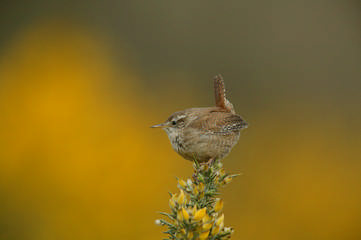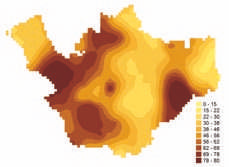
Wren © Andy Harmer
This Atlas survey showed that Wren is now the county’s most widespread breeding species, present in 660 tetrads and only missing from the estuarine saltmarshes. The only change since our First Atlas is that Wrens have bred on Hilbre since the mid-1990s, last known in the 1930s (Hardy 1941).
The key to the Wren’s success is its ability to thrive in a variety of habitats. Fieldworkers recorded Wrens in farmland (32% of records), woodland (29%), human sites (27%) and scrub (10%). The species’ habitat preferences run in the order: first, small woods and clumps of trees with underlying scrub; next, rough vegetation along rivers, streams and ditches; followed by gardens and the edges of farmland ponds, with field hedgerows the least favoured (Williamson 1969). Now, with their population at a high level, it is not surprising that every habitat is occupied.
Wrens were confirmed breeding in 73% of their tetrads, with observers in 163 tetrads recording adults carrying food or a faecal sac, in 206 tetrads seeing recently fledged chicks and finding nests with young or eggs in 111. Male Wrens build several ‘cocks’ nests’, domed balls of moss, leaves and grasses, from which his mate chooses one and lines it with feathers. The same procedure is followed for the almost customary second brood in July. Most nests are in hedges or creeping plants or in holes such as rock crevices, amongst tree roots or, especially in the hills, drystone walls and stunted hedges provide numerous nest-sites. In farm buildings they often build on an old Swallow’s nest, and several observers reported Wrens using nests in artificial sites including under a bridge, in a car port, in honeysuckle against a pole in a garden centre, on the timber frame of a hide at Woolston Eyes, and one found by Tony Coatsworth in Little Bollington (SJ78I), where an adult was feeding chicks in a hanging basket outside a pub.

Wren abundance.
The BTO analysis of Breeding Bird Survey transects shows that this is our seventh most numerous species, with a breeding population of Cheshire and Wirral in 2004-05 of 129,370 birds (108,620-150,110), an average of almost 200 Wrens per tetrad across the county. In the best habitats there are up to 320 birds per tetrad, as the abundance maps shows in scrubby areas along the Mersey valley and south Wirral, and in south-east Cheshire.
There is no long-term trend in the national or local Wren populations but their numbers can fluctuate enormously, dropping to less than one-quarter of their maximum level following the severe winter weather of 1962/ 63, with other large drops in 1978/ 79 and 1985/ 86. In exposed sites, almost every Wren might die, with the population restocked from birds surviving in sheltered farmsteads and villages (Peach et al 1995). In recent years, the limit on their population has been competition from other Wrens as they reach the carrying capacity of the environment.
Sponsored by Andy Harmer

